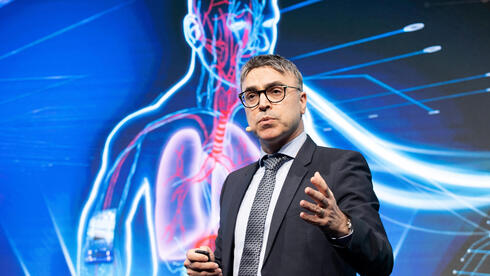
Israel-Japan Conference
"We developed breathing sensors that detect within a minute if the patient is sick"
Prof. Hossam Haick, Dean and Head of the LNBD Group at the Technion, was speaking at Calcalist's Israel-Japan Conference in Tokyo
Prof. Hossam Haick
(Shmulik Dudfur)
"One of the most important factors in the success of the treatment of a disease is early diagnosis, but what happens when the patient does not feel bad and there are no external symptoms of the disease? There is a huge gap today between the importance of early diagnosis and what actually happens, a lack of continuous contact between the population and the medical centers. In our laboratory at the Technion we are trying to bridge the gap between the clinics and the patients through technological developments. How do we do this? Devices and facilities that can be kept in the clinics, but can reach the patients and perform data analysis online," said Professor Hossam Haick, Dean and Head of the LNBD Group at the Technion, speaking at the Israel-Japan Conference.
"One of the things we have developed are breath sensors that know how to identify diseases and the stage of progression. The device detects a kind of odor signature of the disease. A breath sample of the patient is taken for 30 seconds non-invasively and a result is obtained within a minute," Haick continued. "We have already done studies in 23 medical centers around the world. We know how to distinguish between 17 different types of diseases, including cancer and various inflammations. Beyond the diagnosis of "healthy" or "sick", we also know, for example, whether the tumor is benign or malignant, without the need for a biopsy or surgery. Experiments with our device have even shown the ability to detect very preliminary signs of cancer. These are people who are healthy today, but may very likely get cancer because of cells that are already detected in their body."
Haick added that along with the breathing sensors, his lab is developing a kind of sticker that transmits to a smartphone application. "The sticker is reminiscent of children's temporary tattoos. It sticks to the body for several weeks or months and transmits information about the patient's health status. Another challenge we face is imaging devices and technologies. In this framework, we developed an imaging device that includes a sensor and is the size of a credit card. You can use it to distinguish between healthy molecules, breast cancer and a condition that is experienced just before malignant cancer."
Haick concluded by saying that the next step in the development is the integration of the devices with historical data that will allow not only identification, but also the prediction of a patient's health status.
You can watch his full remarks in the video above.















